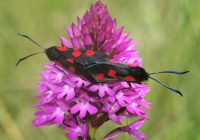Dr Phil Smith’s Wildlife Notes
June 2014
Following on from a bountiful May, this month produced a floristic explosion on the sand-dunes unprecedented in living memory. Bee Orchids were everywhere, Patricia Lockwood and I counting 535 on a walk of about 400m through the Birkdale frontals. Even more abundant were Pyramidal Orchids, a species that a generation ago was hard to find on our coast. Their shocking-pink spikes appeared in many new places, while the Ravenmeols/Cabin Hill dunes held well over 10,000. It was even possible to find the rare white form, var. albiflora, without too much difficulty.
Despite only about half the average rainfall during the month, marsh-orchids also did well, Altcar Rifle Range providing a particularly colourful display of Northern, Southern and Early Marsh-orchids for a guided walk attended by 30 local people on 11th. Earlier that day, I had counted nearly 350 marsh-orchids, the majority Northerns, at Haskayne Nature Reserve, a disused railway cutting a few miles inland from the coast. This is more than double the number I found two years ago and testament to the grassland management carried out by the Wildlife Trust.
Marsh Helleborines were also abundant in the slacks, flowering two weeks earlier than usual. Drifts of this species at the Devil’s Hole were enjoyed by 27 guided walkers on 22nd, while Grass-of-Parnassus also had its first flowers, usually not out until August. The wonderful variety of wildlife seen on this visit included Emperor and Broad-bodied Chaser dragonflies on a flooded scrape, both Five and Six-spot Burnet moths and several superb Dark Green Fritillaries, our most notable coastal butterfly. A patch of Creeping Thistle near the shore proved an irresistible lure to these fast flyers, making it possible to photograph this normally elusive species.
However, the dry weather did not help our Natterjack Toads, many of their breeding sites drying up prematurely. An exception was the two new scrapes at Hightown where rescued tadpoles produced enormous numbers of yellow-striped toadlets.
In the first half of the month, Ainsdale Sandhills Local Nature Reserve was graced by thousands of White Satin Moths , one of the great annual spectacles of the Sefton Coast. It was fascinating to watch the males actively searching for and mating with the freshly emerging females, these sending out an attracting chemical pheromone even before their wings have fully expanded.
Dragonflies are a particular attraction at this time of year, so Trevor Davenport and I visited Martin Mere on 13th to check out some newly-dug ponds that we had spotted in the spring. After a long walk round to the far side of the reserve, we were delighted to find seven species, including several Black-tailed Skimmers, the first Common Darter of the year and lots of freshly emerged Emerald Damselflies. The latter were exceptionally early, being usually seen in July or August. However, there was no sign of the Hairy Hawker, claimed here a couple of years ago but still not confirmed for Lancashire.
One of our many surveys included a study of the of the former Hope School playing field at Ainsdale. Patricia Lockwood and I recorded an exceptional total of 135 species of flowering plants on the 18-acre site. Surprises included 17 Dune Helleborines, two Pyramidal Orchids and 31 Bee orchids. Also interesting was a sizeable population of Maiden Pink. Nationally Scarce and Red Data Book listed as Near Threatened, this declining species sometimes occurs as a garden escape. However, the county recorder, Dave Earl, considers this the most extensive “possibly native” population in ‘Lancashire’.
Non-native plants often feature in our surveys, over a third of the coast’s flora being “alien”. One such is the central-European Crown Vetch, large patches of which were found at Altcar Rifle Range on the annual Conservation Group ‘walkabout’. Crosby Marine Park’s diverse flora also includes many non-natives, perhaps the most spectacular being the violet-blue Triplet Lily, first reported here by Peter Gateley in 2004. We thought it had long disappeared but here it was again on the dunes near Crosby Baths and a great rarity according to national distribution maps




